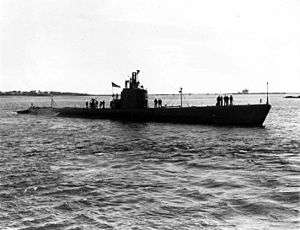USS Runner (SS-275)
USS Runner (SS-275) was a Gato-class submarine, the first ship of the United States Navy to be named for the runner, an amberfish inhabiting subtropical waters, so called for its rapid leaps from the water.
 USS Runner (SS-275), probably photographed during her shakedown period while off the Portsmouth Navy Yard between 30 May & October 1942. | |
| History | |
|---|---|
| Name: | Runner |
| Builder: | Portsmouth Naval Shipyard, Kittery, Maine[1] |
| Laid down: | 8 December 1941[1] |
| Launched: | 30 May 1942[1] |
| Commissioned: | 30 July 1942[1] |
| Stricken: | 30 October 1943 |
| Fate: | Lost after 26 June 1943—Overdue and presumed Lost[2] |
| General characteristics | |
| Class and type: | Gato-class diesel-electric submarine[2] |
| Displacement: | |
| Length: | 311 ft 9 in (95.02 m)[2] |
| Beam: | 27 ft 3 in (8.31 m)[2] |
| Draft: | 17 ft 0 in (5.18 m) maximum[2] |
| Propulsion: |
|
| Speed: | |
| Range: | 11,000 nm (20,000 km) surfaced at 10 knots (19 km/h)[6] |
| Endurance: |
|
| Test depth: | 300 ft (90 m)[6] |
| Complement: | 6 officers, 54 enlisted[6] |
| Armament: |
|
Runner's keel was laid down on 8 December 1941 by the Portsmouth Navy Yard of Kittery, Maine. She was launched on 30 May 1942 sponsored by Mrs. Elise Curry Newton, wife on Admiral John H. Newton, then Commander, Cruisers, Scouting Force, and commissioned on 30 July 1942 with Commander Frank W. Fenno, Jr. (previously captain of USS Trout) in command.
Following shakedown out of New London, Connecticut, Runner departed the east coast in late 1942, and arrived at Pearl Harbor via the Panama Canal on 10 January 1943. Her first patrol, 18 January to 7 March, was conducted in the area between Midway Island and the Palau Islands. Five Japanese cargo ships were claimed as torpedoed on this patrol, but none was confirmed as being sunk.[7] On February 19, 1943[8] in making the last attack of the patrol on a freighter off Peleliu, she was damaged by a near miss from a bomb dropped from a patrol bomber. The concussion knocked out her sound gear and the power supply for both periscope hoists. Runner made her escape by a deep dive, the crew made emergency repairs, and the ship returned to Pearl Harbor for overhaul. For this patrol Fenno received his third award of the Navy Cross.
On her second patrol, 1 April to 6 May, Runner's primary mission was to lay a minefield off Pedro Blanco Rock. Successful in this mission, Runner proceeded to Hainan Straits, off the Chinese mainland. One freighter was torpedoed, and the sound of a ship breaking up was heard over Runner's sound gear, but the kill could not be confirmed. [lower-alpha 1] [9] The submarine returned to Midway Island on 6 May 1943.
On 27 May, under command of Lieutenant Commander Joseph H. Bourland, she departed Midway for the Kuril Islands chain and waters off northern Japan. No report was heard from her. Captured Japanese records indicated that she sank the cargo ship Seinan Maru on 11 June in Tsugaru Strait off Hokkaidō and on 22 June 1943 Runner was attacked and apparently damaged by IJN naval forces.[10] Runner is also credited with sinking the passenger-cargo ship Shinryu Maru on 26 June off the Kuril Islands.[11] Runner was declared overdue and presumed lost in July 1943 and stricken from the Naval Vessel Register on 30 October 1943.
Awards
Runner was awarded one battle star for World War II service.
References
- In fact Runner had torpedoed and damaged the Japanese Army hospital ship Buenos Aires Maru on 24 April 1943.
- Friedman, Norman (1995). U.S. Submarines Through 1945: An Illustrated Design History. Annapolis, Maryland: United States Naval Institute. pp. 285–304. ISBN 1-55750-263-3.
- Bauer, K. Jack; Roberts, Stephen S. (1991). Register of Ships of the U.S. Navy, 1775-1990: Major Combatants. Westport, Connecticut: Greenwood Press. pp. 271–273. ISBN 0-313-26202-0.
- Bauer, K. Jack; Roberts, Stephen S. (1991). Register of Ships of the U.S. Navy, 1775–1990: Major Combatants. Westport, Connecticut: Greenwood Press. pp. 275–280. ISBN 978-0-313-26202-9.
- U.S. Submarines Through 1945 p. 261
- U.S. Submarines Through 1945 pp. 305–311
- U.S. Submarines Through 1945 pp. 305-311
- February 14, 1943 unsuccessful attack on the "Tokyo Maru"
- US Navy Chronology February 1943
- U-boat.net reports on "USS Runner"
- IJN Combined Fleet records
- IJN Combined Fleet indicates Shinryu Maru explosion was due to an unknown cause
This article incorporates text from the public domain Dictionary of American Naval Fighting Ships.